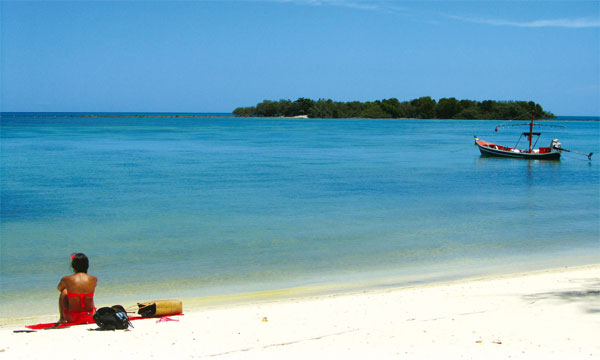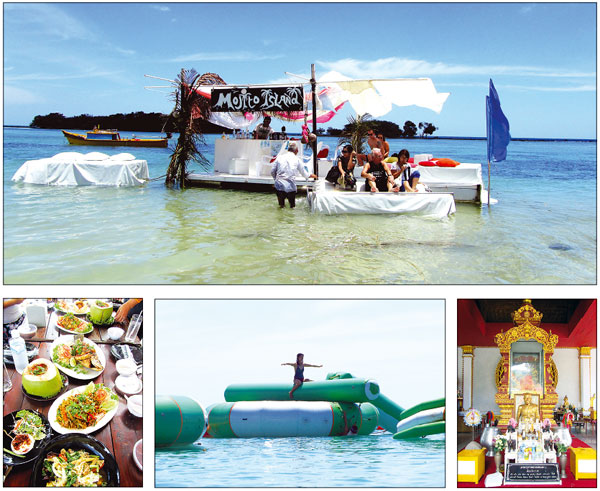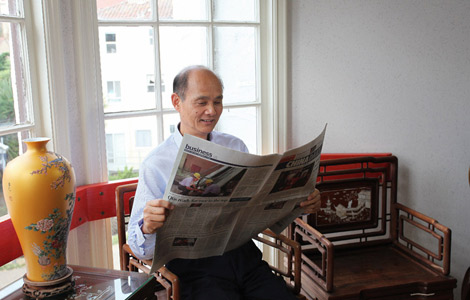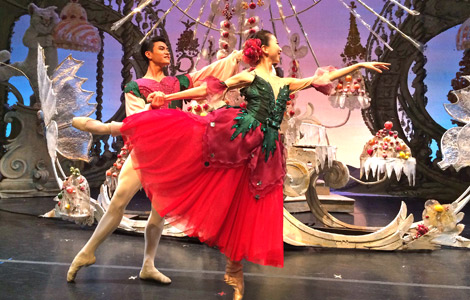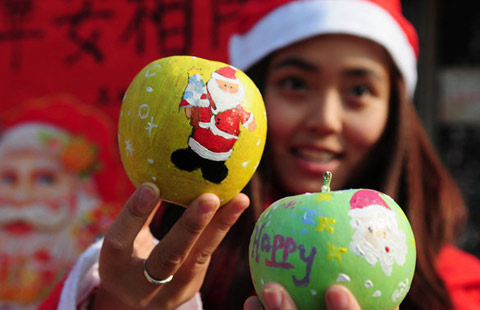Back to the beach
Updated: 2014-12-27 07:51
By Nan-Hie In in Koh Samui, Thailand(China Daily)
|
||||||||
Golden sands, aqua-park fun and a floating bar beckon on Thailand's Koh Samui Island.
It has been a tumultuous year for Thailand after much political unrest in early 2014. Protests rocked Bangkok, then martial law followed after the military seized control of the country in May.
These events disrupted tourism nationwide. For instance, Koh Samui island, off Thailand's east coast, is unlikely to beat the 1.5 million tourist arrivals it achieved last year.
|
Koh Samui, a popular island on Thailand's east coast, is ringed by sandy beaches with clear water and beautiful views. Photos Povided to China Daily |
|
Clockwise from top: Guests at Mojito Island float bar lounge on white sofa beds; a Buddhist shrine at Wat Khunaram; attractions include the Aqua-park at Chaweng Beach Road, with its selection of giant inflatables; guests can savor local dishes such as tom yum soup. |
But in recent months, stability has been restored. Tourism is recovering, including on the tropical island, one of the kingdom's top tourist destinations.
"The impact on Koh Samui was not as significant as in other parts of Thailand," says Ingo Domaschke, general manager of the Ozo Chaweng Samui resort on the island's Chaweng Beach Road.
Resort cancellations did not suffer so badly, he explains, although bookings slowed down in May, June and the start of July. "Now the booking is picking up and getting back to normal," Domaschke says, adding he is "very optimistic" that business will bounce back to pre-coup levels.
Peter Snelson, the owner of a floating bar called Mojito Island, echoes these views. His venue suffered as a result of the booking cancellations that occurred at the height of the country's political crisis. He recalls that several people living abroad had asked him if it was safe to walk down the street, unaware that it was business as usual on the island.
"Now, the type of people that come here say 'What coup?'" remarks Snelson. "It's a whole different kind of tourist that is visiting Koh Samui who is unaware of these problems."
The beaches are relatively crowd-free, while Buddhist temples and other attractions have minimal queues. The aftermath of the political storm has led to a pervading quiet throughout Koh Samui - a quality that many claim had been eroded over years of rampant development on the island.
The downturn in visitor numbers means this is an ideal opportunity to experience a different side of this territory.
Manmade attractions
A typical itinerary to Koh Samui involves a visit to one of its many beaches, but a few manmade attractions emerging on these shores are also drawing attention, including a trend of inflatable operations on water.
The Aqua Park, located near the beach of Ozo Chaweng Samui - a hip and tech-savvy beachfront property by the ONYZ Hospitality Group at Chaweng Beach Road - is no exception. Along the shores of this new resort lies a medley of giant green and white inflatables of different shapes and sizes, designed for climbing, playing and jumping into the island's crystal clear water.
As a result of the drop in visitors to the island, only a handful of swimmers can be seen making the most of having the Aqua Park all to themselves.
Eccentric water activities elsewhere include the island's only floating bar. Mojito Island, at the middle stretch of Chaweng beach, offers a different take on the concept of a beach bar.
Snelson conceived this one-year-old venue to offer an alternative to the island's two most popular activities - dining or swimming by the beach. The floating bar is surrounded by a number of floating white sofa beds in lieu of bar stools, allowing guests to lounge on these platforms and soak up the ocean panorama.
The bartender supplies heavily sweet mojitos while reggae music completes this atmospheric tropical hangout that moves in tandem with the gentle ocean currents.
Snelson, a sailing aficionado, visited many beach destinations to anchor this idea, including beaches in the Philippines and Indonesia, but he found this stretch of eastern Koh Samui best for his concept.
"I picked this place because the reef here protects the boat from the big seas," explains the British national. Post-summer, the winds and waters on this side of the island are calmer - hence the stability of his operation.
The popular venue sold around 4,500 mojitos at its peak in March, but since Thailand's political turmoil, many bookings on the island were canceled. Now, however, the patrons are trickling back again, particularly younger travelers who can be seen lounging on the bar's novel beds with cocktails in hand.
Local charms
Back on shore, the island's numerous local charms beckon. Few are as haunting as a visit to Wat Khunaram in the south of Lamai beach, a Buddhist shrine dedicated to Phra Khru Samathakittikhun (also known as Loung Por Daeng or Luang Pho Daeng), a Thai Buddhist monk who died while meditating in the 1970s.
His remains housed in a glass casket at this mausoleum-turned-shrine show that mummification was practiced by the local Buddhist community.
To many it is a grotesque sight, including the leathery skin and the dark sunglasses that shield his decomposed eyes. But the curious still visit to observe the corpse, and the mystery that perplexes many onlookers is how it has not decomposed significantly, four decades since the monk's death.
The story is legendary on the island. The Koh Samui native died in 1973. Allegedly he foresaw his end, so around a week prior, he ate little while devoting himself to meditation.
The abbot requested his preserved body be showcased in the shrine "as a symbol to inspire the future generations to follow Buddhist teachings and (to) be saved from suffering", reads a plaque at the venue.
The tourist hordes are gone nowadays and most visitors are locals who come to pay their respects.
For a less macabre sample of local culture, visitors can savor the innumerable culinary delights in Koh Samui. Foods distinct to the area include kalamae, Koh Samui's traditional rice and coconut-based candy in mini-pyramid-sized bites.
Kalamae Mae Thunya, a 10-year-old family-run shop, prepares the treats in the most traditional way, as seen inside its kalamae-making facility.
The process begins with large stirring machines where rice is cooked and blended with palm sugar and coconut milk for 15 hours. The sweet, texture-packed morsels - available in flavors like palm sugar and black rice - underscore the culinary ingenuity of this cuisine.
Seafood
Seafood is another must-have. Ringed by beaches, the island is also bedecked with ocean-side restaurants for local platters served against the backdrop of stunning views. At Relax @ Samui restaurant in the northern Bo Phut area, the tables peer over the horizon from the beach.
Well-decorated dishes arrive, including battered seafood in edible deep-fried pastry bowls; the clear, spicy and sour tom yum soup served in coconuts, plus other delectable seafood dishes such as crab and egg curry.
The unpretentious air of this venue - the swing under the tree, the chickens running amok nearby - reflects the simple, slower side of this part of the island where locals outnumber tourists.
For travelers seeking a break from local fare, the US-style grill house Stacked, at the heart of Chaweng Beach Road, delivers fat Angus beef burgers and top-grade steaks.
As the restaurant's name suggests, many dishes arrive 'stacked', including a knife stabbed through its pulled pork burgers or onion rings in towering formation.
The lime-green establishment, particularly the outdoor area, is as lively as one would expect in a venue at the heart of Koh Samui's dining and nightlife district, an area that is well worth a stroll.
Street vendors and a range of entertainment from live music to drag cabarets operate shoulder-to-shoulder on this vibrant street.
These days, however, the area is no longer heaving - an impression previously unimaginable on this well-known island - and again, one of the country's many post-coup effects.
(China Daily 12/27/2014 page19)
Most Viewed
Editor's Picks

|
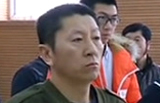
|
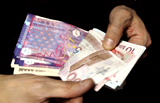
|

|

|

|
Today's Top News
Don't ignore own culture for Xmas, schools tell students
Christmas a day for Chinese food in US
China urged to tap Canada's talent
Research center honors late translator
Chinese dancer joins Nutcracker
Beauty firm's business not pretty in China
Reform set for GDP calculation
'Anti-graft' fight is hottest online topic
US Weekly

|

|
